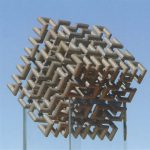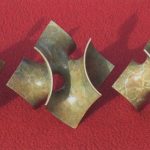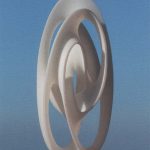Carlo Séquin: Volution’s Evolution
Artist(s):
Title:
- Volution's Evolution
Exhibition:
- SIGGRAPH 2004: Synaesthesia
-
More artworks from SIGGRAPH 2004:


Creation Year:
- 2004
Medium:
- Bronze
Category:
Artist Statement:
Volution refers to a series of shell-like modular sculptural elements. Each is a constrained minimal surface embedded in a cube. The three bronze casts all have similar edge patterns on the faces of a unit cube, consisting of two quarter-circles around opposite corners, with radii equal to half the edge length of the cube. On the inside of that bounding cube, the surfaces exhibit an increasing number of saddles and tunnels, thus evolving the genus of this surface. The simplest shape, Volution_O, is topologically equivalent to a disk. The 12 quarter-circles on the surface of the cube form a continuous, closed edge that defines the rim of this highly warped disk. Fitting the disk to this contorted edge loop results in a dramatic saddle surface with twisted canyons on either side. The bronze cast uses two subtly different patinas to make the two-sided nature of this object more apparent. In the next evolutionary step, represented by Volution_ 1, two central tunnels were added, lying side by side and forming a short-cut connection between pairs of ear-shaped flanges with the same surface color. In adding those tunnels, care was taken to maintain the strict D2 symmetry that is inherent to all three sculptures. Objects belonging to this symmetry group have three mutually perpendicular axes of two-fold rotational symmetry. Finally, in Volution_5, four more tunnels were added to the second shape, enhancing the genus of this surface to a value of 5. If the rim of this surface were extended and closed into a big spherical dome, the resulting surface would be topologically equivalent to a donut with five holes (or equivalently, a sphere with five handles stuck on). Again, 02 symmetry was maintained while these tunnels were added. Each sculptural element on its own displays a remarkable variety of silhouettes, as it is laid down on different edges or stood on three of its protruding tips. The three elements together form a cohesive hyper-sculpture that gains an additional dynamic element from the increasing number of saddles and tunnels in this evolutionary sequence.
Technical Information:
CAD technology was used to define and optimize the shapes of
these sculptures. The geometrically significant fundamental domain of each of these symmetrical objects was first described as a simple polyhedral object that implicitly defines the intended surface connectivity and topology. These objects were then subjected to a few subdivision steps to create smooth surfaces that could be evaluated for their aesthetic appeal. Out of more than a dozen possible shapes with different genus and different rim patterns, the most successful variations were sent to Brakke’s Surface Evolver. Maintaining the rim geometry as a geometric constraint for each surface, the triangle meshes were evolved into close approximations of minimal surfaces. In nature, these
surfaces would not form stable soap films in a boundary frame of corresponding geometry; the slightest disturbance of the symmetry of such a surface would make a saddle “run away” to one side and would lead to a simpler, but lopsided surface. For the surfaces of higher genus, adjacent tunnels would fight one another; the narrower tunnels would contract and pinch off. However, digital optimization on a computer allows us to maintain strict symmetry and overall balance. The optimized meshes were then thickened to a few millimeters by
creating offset surfaces on both sides of the original mathematical manifold. These solid shapes were then saved as .STL-files and sent to a Stratasys Fused Deposition Modeling machine. The three master patterns, each five inches on a side, were made from ABS plastic with this layered manufacturing technique. These plastic originals were then used in an investment-casting process, where they were
burned out from a plaster-of-Paris shell and replaced with molten bronze. Steve Reinmuth was the artist who provided these bronze casts with their intriguing patinas.








